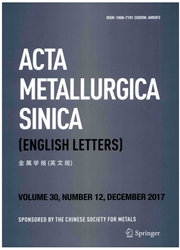

 中文摘要:
中文摘要:
热变丑和 Fe-32%Ni 合金的马氏体的转变行为被电的抵抗和 X 光检查衍射的大小调查。随紧张的增加,奥氏体通过从对变硬工作部分动态地重新使结晶然后到动态地完成了重新使结晶。马氏体的转变特征取决于奥氏体状态。在小紧张变硬工作由于低脱臼密度和很少格子失真对马氏体的转变有用,当由紧张的增加的高脱臼密度和严重格子失真将妨碍马氏体的成核时。一旦动态再结晶(DRX ) 发生,马氏体的转变将再被提高,它与异构的动态基础有关。成长 DRX 谷物能在它的谷物边界附近由于低脱臼密度提高马氏体的成核。
 英文摘要:
英文摘要:
The Hot deformation and martensitic transformation behaviors of Fe-32%Ni alloy was investigated by measurements of electrical resistance and X-ray diffraction. With the increase in strain, the austenite goes through from the work-hardened to the partial dynamcally re-crystallized and then to the completed dynamically re-crystallized. The martensitic transformation characteristics depend on the austenite states. The work-hardening in small strain is helpful to martensitic transformation due to the low dislocation density and little lattice distortion, while the high dislocation density and severe lattice distortion by the increase in strain will hinder the martensitic nucleation. Once dynamic re-crystallization ( DRX ) takes place, the martensitic transformation will be enhanced again, which is related to the heterogeneous dynamic substructures. The growing DRX grain can enhance the martensitic nucleation due to the low dislocation density near its grain boundary.
 同期刊论文项目
同期刊论文项目
 同项目期刊论文
同项目期刊论文
 期刊信息
期刊信息
